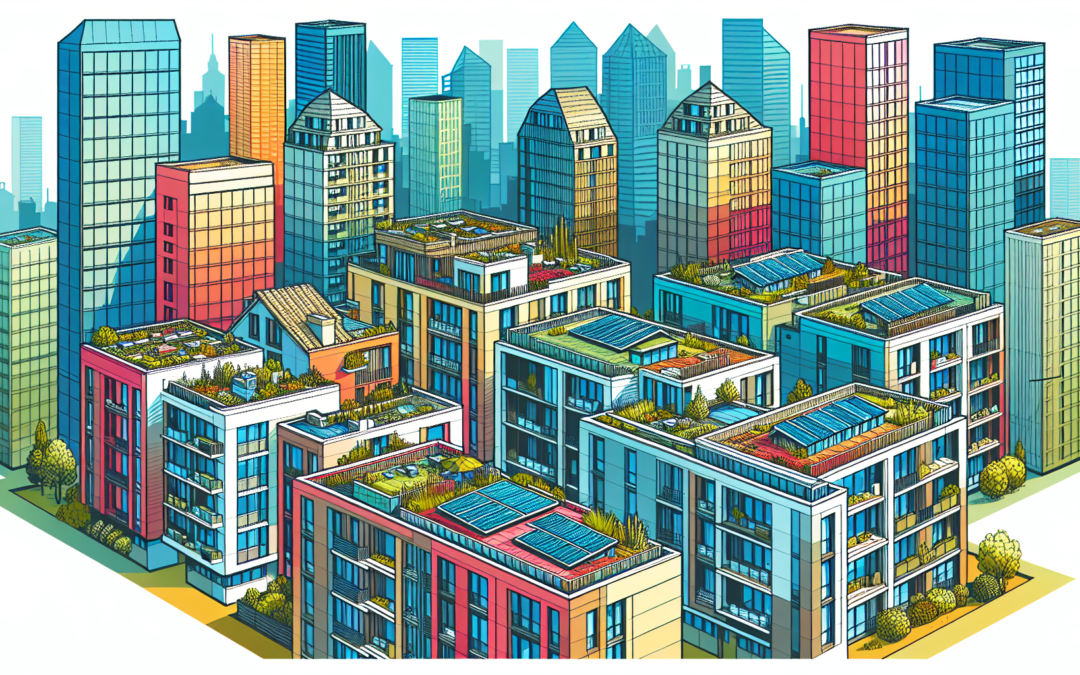
Dec 21, 2023 | Commercial, Roofing
Finding the right team to fix or replace the roof of an apartment can seem like a big task. The roof is super important because it keeps everyone inside safe from rain, snow, and everything else. Here’s a simple guide to help you find the best roofers for your apartment complex.
Know What You Need
Before you start looking for a roofing company, figure out what your apartment needs. Does the roof need small repairs, or does it need to be completely replaced? Knowing this will help you explain your needs to the roofers and get a more accurate estimate of the cost and time needed.
Search for Roofers with Experience in Apartments
Not all roofers have experience with apartment buildings, which are often bigger and have different needs than regular houses. Look for roofers who have worked on apartments before. They’ll understand the special concerns, like making sure everyone’s safe during the work and handling the complex roof structures of apartment buildings.
Check Licenses and Insurance
Make sure the roofing company has the right licenses to work in your area. They should also have insurance that covers both worker’s injuries and any damage they might accidentally cause to your property. This keeps you safe from extra costs if something goes wrong.
Read Reviews and Ask for References
Find out what other people are saying about the roofers you’re considering. Online reviews can be really helpful, but remember to take them with a grain of salt. Asking the company for references, or past clients you can talk to, is even better. If other apartment managers were happy with their work, that’s a good sign.
Request Quotes and Compare
Once you have a few companies in mind, ask each one to give you a detailed quote. This should include how much the project will cost, what materials they’ll use, and how long it will take. Compare these quotes to see which one offers the best value, but remember that the cheapest option isn’t always the best. Quality work might cost more, but it’s worth it in the long run.
Check for Warranties
Good roofing companies stand by their work. They should offer warranties for both the materials they use and their labor. This means if something goes wrong after they’ve finished, they’ll fix it without extra charge, as long as it’s within the warranty period. Make sure you understand what the warranty covers before making your decision.
Communicate Clearly
Once you’ve chosen a roofer, keep the lines of communication open. Make sure they understand your needs and timeline, and ask for updates as the work progresses. Good communication can help avoid misunderstandings and ensure the project goes smoothly.
By following these steps, you’ll have a better chance of finding a reliable and skilled team to take care of your apartment’s roof. Remember, it’s all about protecting your property and ensuring the safety of those who live there, so take your time and choose wisely.

Dec 13, 2023 | Commercial, Roofing
Have you ever looked up at a tall apartment building and wondered about the roof? Apartment building roofs are more than just a cover on top. They hold many interesting features and serve several important functions. Let’s climb up and explore the world of apartment building roofs together!
Types of Apartment Roofs
First off, not all apartment roofs are the same. There are flat roofs, which look exactly how they sound, and pitched roofs, which have a slope. Flat roofs are common in cities, while pitched roofs might be spotted in apartment buildings that look more like large houses. Each type has its reasons, whether it’s for the building’s design or the weather in the area.
Keeping the Water Away
One of the main jobs of any roof, including those on top of apartment buildings, is to keep water out. Flat roofs have a slight slope and drainage systems to make sure rainwater doesn’t pool up and cause leaks. Pitched roofs let the rain slide right off. Either way, the goal is to keep everyone dry inside.
Hosting Special Areas
Some apartment roofs have cool spaces for residents or unique features. Have you ever seen a garden on a roof? Or maybe a swimming pool? These are called amenity spaces, and they’re pretty neat! Not only do they provide fun places for people to hang out, but they also can help keep the building cooler and manage rainwater.
Energy and the Environment
Roofs can also play a big role in making a building friendly to the environment. Solar panels on rooftops catch the sun’s rays and turn them into electricity. This can help power the building and reduce reliance on other types of energy that aren’t as good for the planet. Green roofs, which are covered in plants, help insulate the building, improve air quality, and create habitats for birds and insects.
Safety and Access
Safety is super important for apartment building roofs. There are often rules about who can go on the roof and when, to make sure it’s safe. Sometimes, roofs will have special access points for maintenance people to use, so they can take care of the building and keep it in good shape. It’s not just about having a cool spot to hang out—it’s also about making sure the roof can do its job well.
In conclusion, apartment building roofs are fascinating structures with many roles—from keeping the rain out and providing spaces for fun and relaxation, to helping the environment. So next time you look up at an apartment building, you’ll know there’s more to its roof than meets the eye!

Oct 19, 2023 | Commercial, Roofing
Commercial roofing plays a crucial role in protecting business premises from the elements. With various types of commercial roofing available, understanding the differences, including their benefits, can help property owners and managers make informed decisions. This article will explore the most common types of commercial roofing systems and their respective advantages.
1. Built-Up Roofing (BUR) Systems
One of the oldest and most reliable types of commercial roofing, Built-Up Roofing (BUR), is known for its layered construction. This roofing system typically comprises alternating layers of bitumen (asphalt) and reinforcing fabrics called roofing felts. The multiple layers create a durable barrier that provides excellent protection against water, UV rays, and mechanical damage.
Benefits: BUR systems offer a robust, long-lasting waterproofing solution with relatively low maintenance requirements. Their thermal properties also contribute to reducing heating and cooling costs.
2. Metal Roofing
Metal roofing is increasingly popular for commercial buildings, thanks to its durability, sustainability, and variety of aesthetic options. Common materials include steel, aluminum, copper, and zinc. Metal roofs can be designed to mimic other roofing materials, such as tiles or shingles, making them versatile for different architectural styles.
Benefits: Metal roofs are known for their longevity, with lifespans often exceeding 50 years. They are highly resistant to extreme weather conditions and fire, and they reflect solar radiant heat, which can reduce cooling costs. Additionally, metal is recyclable, making it an environmentally friendly option.
3. Single-Ply Membranes
Single-ply membrane roofing systems are sheets of rubber or other synthetics that can be ballasted (held down with rocks), mechanically fastened, or chemically adhered to insulation creating a layer on the top of a commercial building. The most common types are Ethylene Propylene Diene Monomer (EPDM), Thermoplastic Olefin (TPO), and Polyvinyl Chloride (PVC).
Benefits: These systems are lightweight, flexible, and resistant to UV radiation. They offer excellent weatherability and are relatively easy to install. Single-ply membranes are also effective in reflecting sunlight and heat away from the building, contributing to energy efficiency.
4. Modified Bitumen Roofing
Modified bitumen roofing is an evolution of the older BUR system, incorporating modern materials and technologies. It combines layers of bitumen modified with polymers or rubbers, reinforced with fiberglass or polyester fiber matting, to increase durability, flexibility, and temperature resistance.
Benefits: This type of roofing provides strong resistance against foot traffic, punctures, and tears. It’s relatively easy to repair and maintain, and the installation process allows for greater flexibility in terms of weather conditions.
5. Green Roofing
Green roofing is an eco-friendly solution that involves the installation of vegetation layers over a waterproof membrane, often complemented with a root barrier and irrigation systems. Green roofs can help reduce the urban heat island effect, manage stormwater, and improve air quality.
Benefits: Beyond their environmental advantages, green roofs can enhance the aesthetic appeal of a building, provide additional insulation, and potentially increase the roof’s lifespan by protecting the waterproofing membrane from UV radiation and physical damage.
Conclusion
Choosing the right commercial roofing system depends on various factors, including climate, the building’s structure, aesthetic preferences, and budget. Each type of roofing offers distinct benefits, ranging from durability and energy efficiency to environmental sustainability. Consulting with qualified roofing professionals can help determine the most appropriate option for a specific commercial property.



